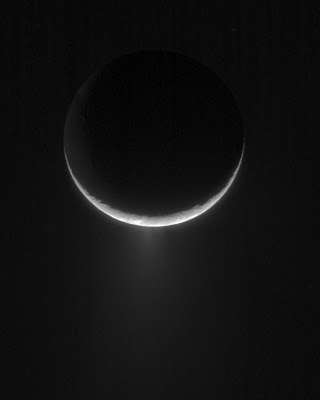Italy, 1610. The x-ray glasses that Galileo Galilei ordered from the Netherlands have in fact turned out to be a peculiar device for enlarging that which is distant. Turning his telescope towards Jupiter, Galileo observes its four moons, the first objects in the celestial sphere to conclusively be shown to be revolving around something other than the Earth. Some time later, he briefly takes a peak at Saturn, but - confused by its rings - he decides he'd probably be better off observing those burly men rapidly approaching from the direction of the Vatican.
England, 1789. Filled with pride at his discovery of Uranus (though he would fortunately die before it was finally named), William Herschel aims the world's largest telescope at Saturn and discovers two new moons, later named Mimas and Enceladus respectively. Enceladus, at this point, and for the next couple of hundred years, was known as nothing more than a white dot. Some further study revealed that it was, in fact, a very white dot. Strangely, the human race remained unmoved.
Robot Visitors
During the latter half of the twentieth century, the great robot exodus began: metal creatures leaving the Earth in droves in the hopes of discovering better working conditions. Voyagers 1 and 2, soliciting employment among the rings of Saturn, took the first close-up photos of Enceladus. Postcards revealed a mysteriously smooth, white world, that was also conspicuously embedded in a diffuse and newly discovered ring.
Could this frigid little ice-ball be geologically active? Is it shooting great gusts of snow into space? How else would its surface be so smooth and crater-free, and where else might this ring come from?
Wish you were here,
Voyager 2
PS. Voyager 1 sends its love.
A Moon's Best Friend
As the twentieth century drew to a close, hardier robots with a stronger sense of commitment were sent into space. Rovers crawled over Mars until their wheels fell off, space telescopes went round and round the Earth until they threw up, and one very plucky 'bot was even bashed around by material ejected from Halley's Comet. Chief among these dedicated pioneers was Cassini, a robotic Flash Gordon complete with lantern jaw and Italian-American pizzazz.
Cassini showed that Enceladus was indeed geologically active, shooting plumes of water ice into space from its south pole. If the complicated mathematics wasn't enough to convince everyone, the photos were. If Enceladus was perfectly snow white, it was because it was coated in perfectly white snow.
What Lies Beneath?
Attempts to explain such activity on a small, cold moon were now a popular topic in planetary science circles. Was this the result of dry, otherworldly chemistry - or was was it due to more familiar mechanisms involving liquid water? One, clearly over-optimistic model suggested that Enceladus might even have warm, sub-surface liquid water, rich in nourishing organic chemicals.
And then, very recently, Cassini dive-bombed the strange tiger-stripe ice formations on Enceladus' south pole, sucking greedily at the rising icy plumes. It sent whispered word back to its friends on Earth, and just this week we learned that the geysers on Enceladus are rich in complex organic chemicals, and the weather among the tiger-stripes is fine (well, relatively speaking, for a world so far from the sun). The question of whether the processes creating these strange geysers is dry or wet remains a mystery, however - and who knows what further mysteries await around the corner from that one?
This is just one of the countless interesting true stories that took place (and continue to take place) out of this world. We notice it especially because it hints at somewhere we might hope to find alien life, and because it is recent. But it's important not to forget the other stories too. When Cassini, Herschel and I get together for drinks, we find it strange that they aren't more widely known.




8 comments:
That was really well written! I'm not kidding around. You have a great way of applying such a distinct voice to the subject. This makes me think of people like Neil Degrasse Tyson, a correspondent a U.S. Public Broadcasting show called NOVA.
You can see this particular guy, Neil Degrasse Tyson, in this clip.
This kind of presentation just have a way of pulling you into a subject and making you want to know more and more about it.
What a wonderful scholarly review of the subject lightened by humor and your distinctive satiric voice! This was a real pleasure to read.
Wonderfully well done! The last sentence is worth it's weight in gold!
Well done, funny and smart. I am glad I stopped by.
too good
WDS
Wish I could join the three of you - I bet those drinks - and the conversation - are out of this world. As is this post - you hit it 'out of the ballpark,' with this one, Pacian!
Oh, how I adore Voyager 2's note! Well done.
"Strangely, the human race remained unmoved."
Hom. sap. is good at remaining unmoved by things of putative significance, while becoming hysterical over self-evident trivia. A fine post, young P.
Post a Comment